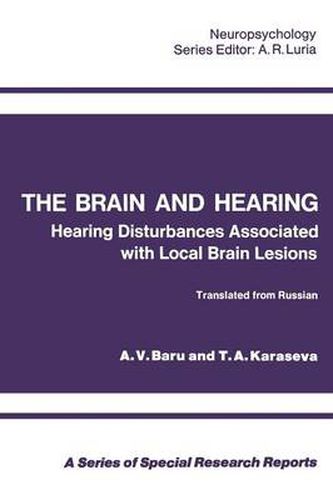Readings Newsletter
Become a Readings Member to make your shopping experience even easier.
Sign in or sign up for free!
You’re not far away from qualifying for FREE standard shipping within Australia
You’ve qualified for FREE standard shipping within Australia
The cart is loading…






This title is printed to order. This book may have been self-published. If so, we cannot guarantee the quality of the content. In the main most books will have gone through the editing process however some may not. We therefore suggest that you be aware of this before ordering this book. If in doubt check either the author or publisher’s details as we are unable to accept any returns unless they are faulty. Please contact us if you have any questions.
One of the ways in which the cerebral organization of sensory sys- tems in general, and the auditory system in particular, can be in- vestigated is by studying defects of the perception and discrimina- tion of acoustic stimuli resulting from destruction of different parts of the auditory system by a pathological focus in them or by their surgical removal. The disturbances accompanying lesions of the peripheral part of the auditory system (disturbances of sound conduction, dis- turbances arising in the ha ir cells of the cochlea) are weIl known. It is much more difficult to determine the character of disturb- ances specific for lesions of the central parts of the auditory sys- tem and, in particular, of the auditory cortex. Types of visual disturbances in man associated with lesions of the visual cortex - homonymous hemianopia with preservation of central vision in unilateral lesions and cortical blindness in bilateral lesions - are described in the neurological literature (Brower, 1936). The visual agnosias found in lesions of the secondary visual areas and inferior temporal zones of the human and animal cortex are also weIl known. Analogous facts showing that destruction of the parietal cor- tex disturbs complex (epicritic) forms of sensation but leaves more elementary sensation (protopathic) intact are described by Head.
$9.00 standard shipping within Australia
FREE standard shipping within Australia for orders over $100.00
Express & International shipping calculated at checkout
This title is printed to order. This book may have been self-published. If so, we cannot guarantee the quality of the content. In the main most books will have gone through the editing process however some may not. We therefore suggest that you be aware of this before ordering this book. If in doubt check either the author or publisher’s details as we are unable to accept any returns unless they are faulty. Please contact us if you have any questions.
One of the ways in which the cerebral organization of sensory sys- tems in general, and the auditory system in particular, can be in- vestigated is by studying defects of the perception and discrimina- tion of acoustic stimuli resulting from destruction of different parts of the auditory system by a pathological focus in them or by their surgical removal. The disturbances accompanying lesions of the peripheral part of the auditory system (disturbances of sound conduction, dis- turbances arising in the ha ir cells of the cochlea) are weIl known. It is much more difficult to determine the character of disturb- ances specific for lesions of the central parts of the auditory sys- tem and, in particular, of the auditory cortex. Types of visual disturbances in man associated with lesions of the visual cortex - homonymous hemianopia with preservation of central vision in unilateral lesions and cortical blindness in bilateral lesions - are described in the neurological literature (Brower, 1936). The visual agnosias found in lesions of the secondary visual areas and inferior temporal zones of the human and animal cortex are also weIl known. Analogous facts showing that destruction of the parietal cor- tex disturbs complex (epicritic) forms of sensation but leaves more elementary sensation (protopathic) intact are described by Head.